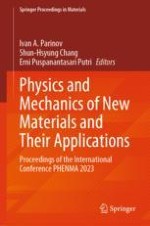This book presents 60 selected peer-reviewed contributions from the international conference Physics and Mechanics of New Materials and Their Applications, PHENMA 2023 (3-8 October, 2023, Surabaya, Indonesia), focusing on processing techniques, physics, mechanics, and applications of advanced materials. The book describes a broad spectrum of promising nanostructures, crystal structures, materials, and composites with unique properties. It presents nanotechnological design approaches, environmental-friendly processing techniques, and physicochemical as well as mechanical studies of advanced materials. The selected contributions describe recent progress in energy harvesting and piezoelectric materials optimization, electromagnetoelastic actuators for nanotechnology research, impedance spectroscopy and study of ceramic materials, catalyst synthesis and control of morphological characteristics, synthesis and study of electrocatalysts for fuel cells. The presented results are important for ongoing efforts concerning the theory, modelling, and testing of advanced materials. Other results are devoted to the analysis of technogenic raw materials and different material applications in science, technique and industry.
